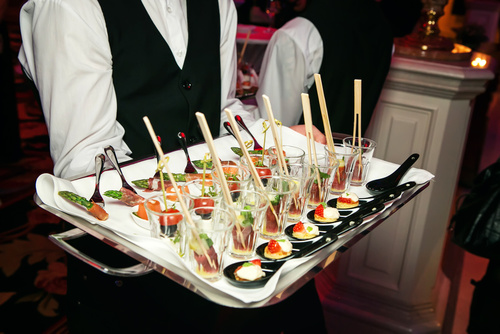#food #finger #Knights #eating
“Finger foods are often served at formal events and celebrations in the form of passed hors d’oeuvre, where they create a casual, relaxed atmosphere and keep guests’ hands and fingers entertained”–Paul Ebeling
Finger foods are small, individual portions of food that are eaten out of hand. They are often served at social events. The ideal finger food usually does not create any mess, but this criterion is often overlooked in order to include foods like tacos, which Knights do not include. The western origin for finger foods is the French canapé.
But, finger foods do not share common origin, history, or identity.
Most of them originate in Hors d’oeuvre like canapé. During the Middle Ages formal French meals were served with entremets between the serving of plates. These secondary dishes could be either actual food dishes, or elaborate displays and even dramatic or musical presentations.
In the 14th Century, recipes for entremets were mostly made with meat, fish, pork and vegetables. By the 15th Century the elaborate display and performances were served up between courses, and could be edible or displays of subjects relevant to the host, created in butter sculpture or other types of crafted work.
With the introduction in the 17th Century of service à la française, where all the dishes are laid out at once in very rigid symmetrical fashion, entremets began to change in meaning but were still mainly savory. Along with this came elaborate silver and ceramic table displays as well as pièces montées. The entremets were placed between the other dishes within the main work of the meal.
One kind of finger food is the French canapé, known since the late 1700s. Canapés began as slices of toasted or fried bread with various toppings. Their name, literally ‘sofa’, was inspired from how the toppings “sat” on the bread as though it were a sofa. Over time, canapés became a word to describe all finger foods served at parties. Hors-d’oeuvres (1623) by Pieter Claesz
Drinks before dinner became a custom towards the end of the 19th Century. As this new fashion caught on, the British took inspiration from the French to begin serving hors d’oeuvres before dinner.
A cocktail party is considered a small gathering with mixed drinks and light snacks. Hors d’oeuvres may be served as the only food offering at cocktail parties and receptions, where no dinner is served afterward.
Prior to the WWI, American dinner guests would be expected to enter the dining room immediately where drinks would be served at the table with appetizers. This changed by the 1920s, when hors d’oeuvres were served prior to a non-alcoholic cocktail; however, after the repeal of Prohibition in the United States, cocktail parties became popular with many different hors d’oeuvres meant as something to help counter the stronger drinks. It is the cocktail party that helped transfer the hors d’oeuvres from the formal dining table to the mobility of the serving tray. These appetizers passed around the cocktail party may also be referred to as canapés.
Most fast food is finger food and quick to eat, even on the go. But never at Knights’ formal events.
Eat healthy, Be healthy, Live lively









